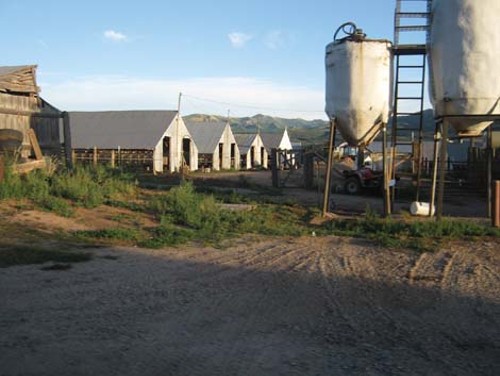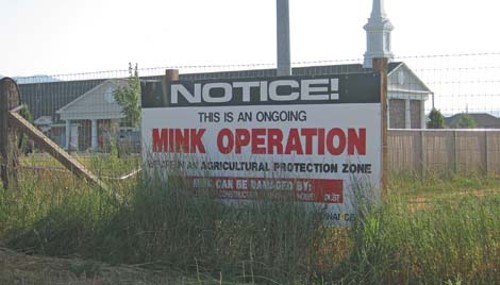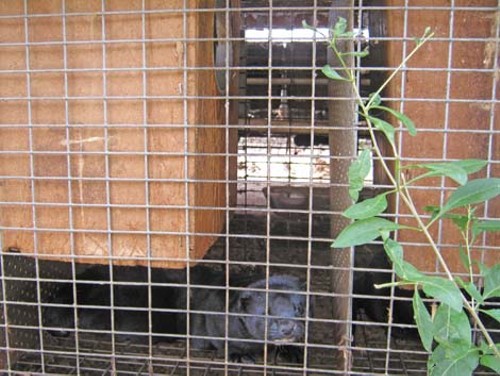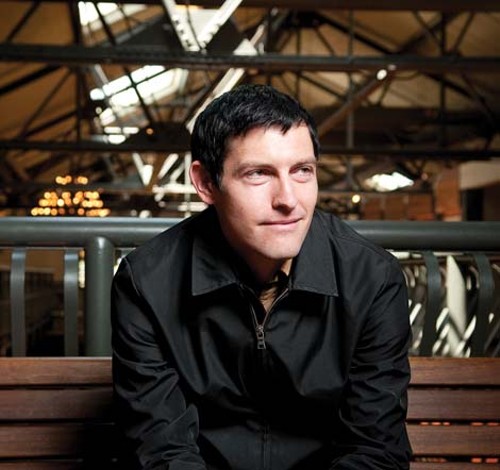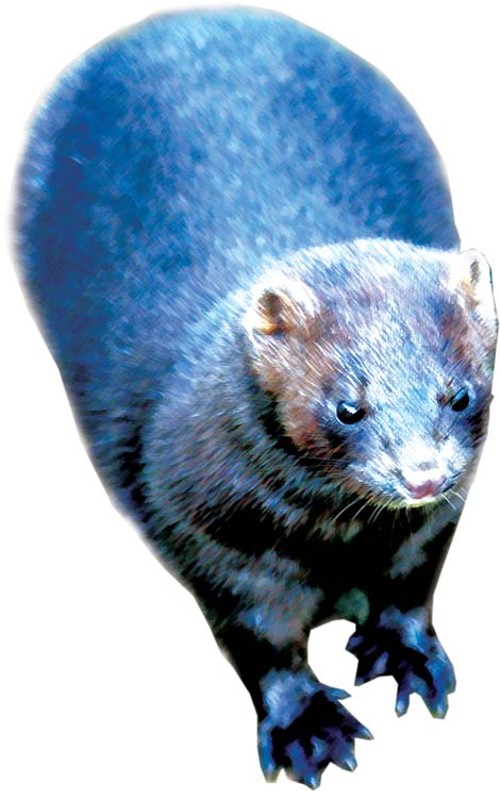Animal Activists Fight for Their Own Rights
Some Utah animal advocates fear being put in a legal cage.
By Jesse FruhwirthIn June 2008, Jeremy Beckham took a day trip from Seattle to Vancouver, British Columbia, with his girlfriend and brother to visit famed Capilano Suspension Bridge. The longtime Salt Lake City animal-rights activist had no problem entering Canada, but his name was flagged by the U.S. Customs and Border Protection when he returned.
“They brought me in a separate room, so it was clear they were singling me out,” he said. He gave the agent his name, told him he was a student at the University of Utah and that he was just visiting Canada as a tourist. “Then [the agent] said, ‘What student groups or political organizations do you belong to?’ ” Nervous already, Beckham was now alarmed. Why should his political beliefs have any bearing on his re-entry?
Beckham, 25, refused to answer the question, and all others.
The agent asked if he was refusing to cooperate with a “national security investigation.” Beckham’s answer was not what the agent wanted to hear: “I’m not refusing to [explain] why I was in Canada, [but] I’m not going to answer questions about my political beliefs.” Beckham was cuffed, and he recalls the agent saying, “You can sit there until you’re ready to answer some questions.”
He sat handcuffed for an hour or more. Eventually, a “good cop” with a kind demeanor—to contrast the previous brusque “bad cop”—came into the room and uncuffed Beckham. He asked the same questions as the first agent and Beckham explained, for a second time, his trip to the Capilano bridge.
“Let me tell you a bit about why you were stopped,” Beckham says he was told. “We looked into you, and we know that you are an animal-rights activist. … That’s your right. You might not be aware of it, but Canada is a hotbed of violent animal-rights extremism. … We don’t think you’re a violent animal-rights activist necessarily, but we have to ask these questions. Did you speak with any animal-rights activists [in Canada]?’” Beckham remained silent.
Twenty minutes later, he was free to go.
It’s not clear whether Beckham was listed in the FBI’s Terrorist Screening Database, or “watch list” as it’s frequently called. Beckham has never been charged with any so-called “eco-terrorism,” but people he knows have, and activist associates of his have been convicted of picketing-related charges. Beckham believes the government hypes the threat of animal-activist crimes in order to disrupt the entire movement and that merely being an animal activist can make you guilty by association. Beckham and others believe animal exploitation is the moral equivalent of human torture or murder, and they’re incredibly earnest and uncompromising in their beliefs that breaking the laws to free animals is similar to the Underground Railroad.
"They brought me in a separate room, so it was clear they were singling me out. Then the agent said, ‘What student groups or political organizations do you belong to?’ ”
Agree with them or not, understanding their motivation is key to understanding tactics that some find unsavory: picketing at animal researchers’ homes, for example, or publicly praising illegal mink releases. While some activists have purposely violated the law in defense of animal rights, those who are not willing to cross legal lines face anxiety-inducing quandaries: When does free speech become illegal support of others’ crimes, and what are the consequences of being an “eco-terrorist” sympathizer?
Law enforcers from the FBI down to Salt Lake City Prosecutor Sim Gill remind these activists that ignorance of the law is no excuse for violating it, and yet refuse to issue legal opinions that clearly distinguish illegal behavior and free speech. An FBI official recently told City Weekly that the activists have nothing to worry about if they “don’t push the envelope.” But activists are almost sure to keep pushing. In which case, they may face more detentions at the border, FBI informants in their midst and more revisions to the legal understandings of free speech and assembly.
Animal-Rights “Rock Star”
Peter Daniel Young, 32, is certainly the most prominent animal liberator/convicted “eco-terrorist” in Utah. The son of a radio disc jockey, Young was born in California and mostly raised in the Seattle-area community of Mercer Island. Already a hardcore music fan and Straight Edge kid—meaning he loved aggressive, angry music but disdained drugs and alcohol— Young became only the second vegan in his high school and hasn’t eaten meat or dairy since, not even in prison.
The roots of his radical respect for animals can be traced to John Robbins’ markedly unradical Diet For a New America television special from 1992, which Young saw in a high school class. The 60-minute film barely mentions animal rights and focuses on Americans’ unusual levels of meat and dairy consumption relative to other countries. There’s just a brief scene about the conditions of animals on factory farms, but it’s presented as more of a gross-out to eaters than an argument that animals deserve better treatment. Nevertheless, those images stuck with Young.
Young graduated from high school in 1995 and continued his practices of picketing businesses that exploited animals. He quickly grew intolerant, however, of the slow pace of progress and moved on to criminal acts of activism, often referred to as “direct actions.” “We were under the illusion that this [picketing] was building up toward some crescendo where all the animals were free, and it just wasn’t working.”
His first illegal direct action was to smash the windows of a Seattle ham store and paint “Meat is Murder” on the walls. That made the news, as did other crimes he committed anonymously. Before long, though, both cops and news crews recognized him as an activist. He felt “marked” and needed anonymity to continue his illegal work, so he headed for the Upper Midwest in 1997.
“The road trip that lead to my indictment was to be my last stop before college,” he said. “I wanted to do one last, great thing.” That thing was to assist in the release of thousands of mink from their cages at six ranches in South Dakota, Iowa and Wisconsin, sort of an epicenter of mink farming. Wisconsin is the top producer of mink pelts with 71 farms, according to the U.S. Department of Agriculture. Utah is the second highest, with 65 farms.
Mink are among the best animals to liberate, Young says, because they’re scrappy survivors who have the instincts for life in the wild. The fur industry disagrees about minks’ chances of survival after a lifetime in a small cage—which is usually only months long—never having time to run around, much less hunt or swim. Each side has anecdotes and scientific research to back their mortality/survival claims.
Young and a co-defendant were caught—their red Geo Metro with Washington plates had been spotted at mink farms and was seized by a Wisconsin officer—but he was not indicted until the next year. Young went underground and stayed on the lam until 2005, when he was arrested in San Jose, Calif. He pleaded guilty and was sentenced to two years in prison and $254,000 in restitution, most of which went unpaid because he stopped making payments after his one-year probation expired.
Young became a convicted eco-terrorist, though he never intended to nor actually did hurt anyone—except financially. He sees mink releases as akin to interrupting a rape in progress, so he doesn’t have any mixed emotions about harming animal-exploitation businesses. He says he’s now engaged only in above-ground, legal activism because, as a “marked” man, he attracts a lot of law-enforcement attention.
Young also drew attention of animal-rights activists, becoming a “rock star” among local groups, at least according to a woman who once dated Young and is now suspected of working as an informant for the FBI.
Spooky Gal
Sarah Bobbitt was 26 when Young first met her in the spring of 2008.
Attractive, blond, a conservative Republican, she was a photographer who worked for the University of Utah’s Daily Utah Chronicle and offered to arrange for photos from protests to appear in the student newspaper. “She was strange but disarming at the same time,” Young said. Young was not yet a Utah resident, but on a speaking tour passing through the state. Bobbitt approached him about helping her with “a campaign to rescue Guatemala street dogs, or something,” Young said. She asked to go out for dinner after the conference, then asked if she could stay with Young’s hosts who were putting him up for the night. He obliged.
“She was very forward,” Young said, but never answered whether he was sexually or romantically interested in her. Bobbitt says she briefly dated Young.
Young’s Utah comrades, he says, quickly pegged her as a snitch. She dressed conservatively and asked inappropriate questions about illegal activities—most activists are leery of informants and adhere to “security culture” (pdf) (in which information on illegal activities is discussed only on a need-to-know basis). He defended her, saying “snitch jacketing” someone prematurely is unfair and counterproductive.
Young continued on his speaking tour but returned to Utah shortly after two fur farms—one in South Jordan in August 2008, another in Kaysville a month later—had been sabotaged by activists, who released thousands of mink. The Animal Liberation Front, a nom de guerre frequently adopted by activists who anonymously take credit for illegal actions against animal enterprises, took credit for the incidents. ALF is listed as a domestic terrorism group by the FBI.
“He was the type that was always [saying,] 'When are we going to stop talking and go blow up something?' "
DAVID BERG
When Young and Bobbitt met again, she invited him to Moab for the weekend.
The trip got weird before they even got to Price. Young and Bobbitt were stuck in a car together for hours, and she asked several questions about the recent mink releases, Young says, questions which hung in the air like flatulence.
The weekend ended worse than it started. They fought, Bobbitt left him, and Young was deserted in downtown Moab, where he knew no one and had no transportation.
Why is Bobbitt suspected of being an informant, or a confidential human source (CHS), as the FBI calls them? An FBI reporting document (pdf) describes the trip this way:
“CHS reported that Peter Young arrived in Utah about two weeks ago. … CHS traveled with Young to Moab, Utah, on Thursday, September 25, 2008. CHS returned to Salt Lake City on Sunday without Young and hasn’t talked to him since.”
When City Weekly contacted Bobbitt, she denied being an informant. The Facebook conversation she had with City Weekly went silent after she was asked about the seemingly incriminating FBI document, which was provided by the government to defense attorneys for William “BJ” Viehl, 23, and Alex Hall, 21, two men who pleaded guilty in U.S. District Court to releasing the mink at the South Jordan ranch in August 2008. Other documents suggest Bobbitt may have had repeated contacts with the FBI that summer about other activists.
Of the trip to Moab, Bobbitt wrote: “I am not an FBI informant and yes this is starting to have an unfortunate effect on my life. ... I briefly dated Peter nearly two years ago and haven’t talked to him since. It ended with me leaving him a long way from home, I know I pissed him off, but he was unstable, manipulative and honestly scared me. … And as for the ‘several people’ [activists who believe Bobbitt was an informant], I can only imagine they are the snobby elitists with whom I actually tried to be friends with in fighting for a similar cause. All I can guess is that they pegged the girl that didn’t fit in and who didn’t buy into their rock star’s manipulative ego.”
Beckham is disturbed by informants. He thinks it keeps people from supporting animal rights and other social-justice movements. People think, “if the government is monitoring it, there must be something wrong with it,” Beckham said.
Bobbitt is not the first individual thought to be an FBI informant by animal rights activists, so they’re always on alert. In 2001, City Weekly investigated Richard Stone, who activists complain acted more like a provocateur than an informant as he sat in on meetings to arrange protests against the 2002 Olympic Rodeo. “He was the type that was always [saying], ‘When are we going to stop talking and go blow up something?’ ” says David Berg, a Salt Lake City man involved in the pre-Olympic protest planning. According to Berg, Stone even accompanied the activists to a meeting with the American Civil Liberties Union of Utah organized to discuss protesters’ rights.
Busy Litigants
Though
some complain about being treated like terrorists, there are some stark
contrasts between them and suspected terrorist jihadis. Detainees at
Guantanamo Bay, for example, have been detained for nearly a decade
without being charged with a crime. The closest local situation with
any similarity—remote though it may be—is that of Jordan Halliday, 22,
principle organizer of a local Animal Defense League chapter, who spent
four months in civil detention for refusing to testify before a federal
grand jury about the local mink releases. Halliday says that he
endorses mink releases and believes he’s being targeted for his speech.
“[Federal prosecutors] are trying to view me on the same terms as any
ALF member because I’m vocally supportive of it,” he said. He was freed
at the expiration of the grand jury but soon after was charged
criminally with contempt, which could send him back to prison for years.
Often, the activists are in court as litigants, not defendants, and have successfully argued multiple times that their rights have been violated.
The most recent example involved a protest at a mink farm in Morgan County. Members of the Salt Lake Animal Advocacy Movement argued in a federal lawsuit that Morgan County and the Utah Department of Public Safety violated their rights to protest near a mink farm in November 2008. In February, the case was settled, which netted civil rights attorney Brian Barnard nearly $40,000 in legal fees from the state and county.
The criminal penalties they suffer have also been rather modest, compared to other convicted terrorists or even to drug convicts, despite complaints that the Animal Enterprise Terrorism Act of 2005 lumps them together with other terrorists. Viehl, for example, was sentenced to two years in prison in February but expects to be released from prison in just five months, he wrote to City Weekly in a letter. He was given credit for time served pretrial.
The [FBI] does not intimidate political groups with investigation tools like search warrants. “That happened in the ’70s … but the Attorney General’s guidance on that is very clear, we’re not authorized to do that.”
In 1997, the most destructive act of eco-terrorism in Utah history was committed against the Fur Breeders Agriculture Co-op in Sandy, a farmer-owned co-op that provides livestock food, when an incendiary device started a fire that caused about $1 million in damage. Brothers Douglas Joshua Ellerman, then 21, and Clinton Colby Ellerman, then 22, later pleaded guilty to explosives charges and served seven years and five years each in prison, while a federal jury acquitted three others charged in the incident. None are currently active in local animal rights groups.
Recently, five activists were acquitted after being charged with violating Salt Lake City’s targeted-residential picketing ordinance, passed in July 2007, to manage animal rights protests at the homes of University of Utah researchers who use animals in their experiments [see “Residential Picketing Case Ends in Acquittals,” May 6, City Weekly]. At least six residential demonstrations were held after the ordinance passed without arrests, says acquitted picketer Thomas Risk, but at the seventh demonstration, 16 picketers were cited. Others were convicted, four of whom are appealing.
But another case local activists have no direct relationship to has them worried. The so-called SHAC-7 case, upheld by the U.S. 3rd Circuit Court of Appeals in December, charged six activists and their organization—Stop Huntingdon Animal Cruelty—with animal-enterprise terrorism and stalking. The group coordinated protests at the homes of officials from Huntingdon Life Sciences, an animal-testing agency based in New Jersey.
No one was charged with actually vandalizing property, issuing violent threats or trespassing, though prosecutors presented unproven evidence of those crimes and others. The SHAC-7 were nevertheless convicted of encouraging and supporting illegal activities, in part, by posting addresses on its Website and cheering on illegal acts that they say were committed exclusively by others. The Center for Constitutional Rights has asked for an en banc review of the 3rd Circuit panel’s decision, stating Americans have long been allowed to condone illegal behavior. CCR argues that what the SHAC-7 did with their Website was “menacing public speech,” which has been protected by the courts in the past, not a “true threat,” which is not protected.
The case deeply concerns Young. He’s the closest thing to a SHAC-like entity in Utah. Since his release from prison, he’s compiled The Blueprint, a national directory of hundreds of mink farms across the country and distributes it on his Website. Previous to Hall and Viehl being arrested, he offered a $2,500 defense fund to anyone arrested in connection with the mink release. He repeats ALF communiques posted on other Websites. He publicly endorses illegal actions like mink releases.
Could he be investigated for supporting illegal activities based on those facts alone? Industry spokeswoman Teresa Platt is curious about that very question. As the executive director of Fur Commission USA, she knows Young by name, as well as Viehl, Hall and others. Indeed, she thinks the “terrorist” label is appropriate for them and says ranchers who use animals are a persecuted minority. “They’re just ordinary, hard-working people trying to figure out how to deal with these crimes of special-interest domestic terrorism,” she says. She says the roughly 40-year history of illegal animal-rights actions has contained many violent threats and some actual violence against ranchers and animal researchers, and thus, many animal rights actions now carry an implicit threat and encouragement of violence. “If you read some of [Young’s] statements, they’re borderline incitement, right? He does offer people money should they get caught breaking the law. Is that incitement? … He’s probably had legal advice on what he can and can not say, but he is close.”
The FBI won’t say how close he is, but it seems the FBI already associates Young with at least one of the 150 eco-terrorism investigations the FBI acknowledges are ongoing.
The Feds
In March, Young moved to Salt Lake City, where most of his eight roommates are animal-rights activists, vegan and Straight Edge. The entire household was served a search warrant by the FBI on March 15 that authorized the agents to seize any materials that may contain information about Young’s travels, associates, or communications that may be connected to “animal enterprise terrorism.” Cell phones, iPods, pictures and computers were taken, not just from Young, but from some of his roommates.
The warrant was issued out of the U.S. Attorneys Office for the Southern District of Iowa where Scott DeMuth, 22, of Minneapolis, is on trial, accused of vandalizing a University of Iowa animal research laboratory in 2004. Young says he doesn’t even know DeMuth, nor did he have anything to do with the Iowa incident, but he blogged critically of the prosecution on multiple occasions, both before and after the raid. He believes federal law enforcement is trying not just to hassle and make people distrust him, but to do that to the entire household of activists. Young’s roommate, Matt Bruce, and others in the house believe the FBI purposefully waited for Young to move in—only four days prior to the raid—in order to instill fear and gather possessions from all of them. “It’s definitely been an activist house for years,” Bruce said.
Many of the activists want to utilize all legal means in pursuit of their goals, and they want clear direction from law enforcement on what, for example, prompted the FBI to sic an informant on them. How can they avoid being investigated in the future but still fully flex their constitutional rights? Is that even possible?
On the municipal level, they have on multiple occasions asked Salt Lake City officials for clear guidance on the residential targeted picketing ordinance and have gotten nothing—no advice and no guidance. Salt Lake City Prosecutor Sim Gill told City Weekly, “My job is not to give legal advice.”
Especially in the face of the SHAC-7 case and what it represents to them, the activists complain, that’s not good enough.
Assistant Special Agent in Charge Kenneth Porter, of the FBI field office in Salt Lake City, compares that sentiment to “children asking their parents how far they can go without being spanked.” He has parentlike advice as well: “Don’t push the envelope.”
Local FBI officials say the line between free speech and illegal support of others’ crimes is determined on a case-by-case basis, so they can’t provide a detailed guide on how to approach the line of legality without crossing it. FBI Chief Division Legael Counsel Trent Pedersen said that if activists are spotted in the middle of the night near a mink farm—as Viehl and Hall once were—they might be investigated for genuine concerns that they are planning to commit a crime—which is itself a crime under federal law. But what if the activists are in a researcher’s neighborhood late at night holding candles, which local activists have done during vigils? Does that justify a full-blown terrorism investigation involving informants, search warrants and all? The FBI won’t say.
The FBI also declined to discuss the local mink releases from 2008, because even though both Hall and Viehl have pleaded guilty, Hall has yet to be sentenced, and the bureau rarely comments on active cases. Likewise, the FBI wouldn’t comment on FBI informants past or present the search warrant at Young’s home or whether Beckham is listed on a terrorist watch list.
Pedersen says no group is targeted because of its political beliefs and says the bureau does not intimidate political groups with investigation tools like search warrants. “That happened in the ’70s … but the Attorney General’s guidance on that is very clear, we’re not authorized to do that.” If a political group is to be investigated for suspected criminal activity of its members, he said, “the First Amendment is our guide” and extra precautions are taken to ensure the investigation won’t violate anyone’s constitutional rights.
Which may not be an easy task. Like Young, Viehl and Hall started as above-ground activists and hung around people from local animal-rights activist groups. That doesn’t mean anyone else in those groups encouraged Viehl and Hall to free mink or even knew they planned to do so, but it could explain—and, for some, justify—the use of informants and other investigation techniques that intimidate, scare and aggravate law-abiding activists even as they help determine the identities of guilty vandals.
Beckham, for one, worries government obstruction of legal actions is part of the inspiration for illegal actions like ecoterrorism. He quotes John F. Kennedy, who said, “Those who make peaceful revolution impossible, make violent revolution inevitable.”
Speaking of...
-
Vegan activists raided by feds--again
- Aug 13, 2010
-
Vegan activists condemn raid of their home by FBI
- Mar 17, 2010
-
SLC home raided; FBI search warrant names activist Peter Young
- Mar 16, 2010
- More »
More by Jesse Fruhwirth
-
Johnny's Rotten
Johnny Bangerter wants to move forward as an activist but just can't shake his racist punk past
- Apr 10, 2013
-
Right of Way
Eviction of Occupy SLC is a loss for community
- Nov 23, 2011
-
The Limbo Party
Redistricting: How low can Utah Dems go?
- May 19, 2011
- More »
Latest in Cover Story
Readers also liked…
-
Forget the family pedigree—Robert F. Kennedy Jr should not be the next president of the United States
Trojan Horse
- Jun 21, 2023
-
Women decry harassment and toxic culture at St. George auto dealership
Men at Work
- Oct 11, 2023



